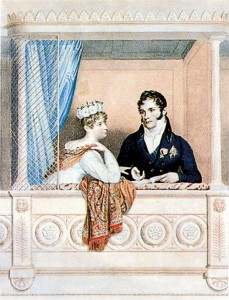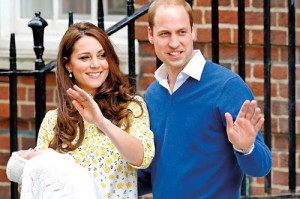The point of a Princess
When Andrew Morton asked the question “What is the point of a Princess?” in his light-hearted look at the day-to-day life of the then Princess of Wales, in his book “Diana’s Diary”, he answered his own question by saying: “The point of a Princess is to be pretty!” Of course, he was speaking of a Princess who had become a fashionista and an icon, but Diana was not born a princess; she became one through her marriage to a prince, just as Catherine Middleton has done.

Portrait of Princess Charlotte Augusta of Wales and Leopold. (Pic courtesy commons. wikimedia.org)
No such transformation is necessary for a Princess born. Thus the advent of Princess Charlotte of Cambridge on May 2, is something altogether different. She is a Princess born, an indelible title, marking her path for life. Nevertheless, the media were keen to point out that the little princess could generate a billion pounds in revenue, even before she comes of age, for the clothes and fashion and cosmetics industries- thus making Andrew Morton’s point. Even if Charlotte does not turn out to be conventionally pretty, she will nonetheless be attended by every artifice and creation the fashion world can contrive, and every jewel in the coffers of a royal family famous for its fabulous collection from its Imperial past.
But of course, she is much more than that. As the most prominent princess to be born since Princess Anne, the Princess Royal, in 1950, and at present fourth in succession to the throne, she will attract media attention, and more serious consideration too, for a long time to come.
The choice of her names, Charlotte Elizabeth Diana, ended days of quite frenzied speculation and gambling – Alice also being a possible choice apparently, the name of the Duke of Edinburgh’s mother, and the name of Queen Victoria’s second daughter; and that Queen’s grand-daughter, Alice of Albany, afterwards of Athlone. This last lady had the distinction of being the longest-lived member of the royal family, only dying in 1981, at the age of 98. Of course, this was overtaken by Queen Elizabeth the Queen Mother, who lived to be 101, and who died in 2002, but again, this Queen had not been born royal.
But the name of Charlotte has proved a refreshing change, for there have been no royal Charlottes in the United Kingdom, since the Heiress Presumptive to the Crown, Princess Charlotte of Wales, died tragically in childbirth in 1817. Indeed, the manner of her demise is probably the reason why the name was not used again at that time. Charlotte was the daughter, and only child, of the Prince Regent, afterwards George IV. It was technically possible that her father could have married again, after the death of her mother, Queen Caroline, in 1821, but that marriage had been notoriously unhappy, and there remained also the question of her father’s invalid marriage to the Catholic widow, Maria Fitzherbert, in 1785. Certainly George IV had no further plans for marriage!
Princess Charlotte would have been Queen if she had lived, being the only legitimate grandchild, at her birth, of her grandparents King George III and Queen Charlotte. Even though the King and Queen had had fifteen children, thirteen of whom grew to maturity, Charlotte was the only

Happy family: Prince William and Kate, Duchess of Cambridge and their newborn baby princess, pose for the media as they leave St. Mary’s Hospital’s. (Reuters)
legitimate grandchild! She was, not unnaturally, the darling of the nation, and the outpouring of grief at her death was not equalled until the death of Princess Diana in 1997, one hundred and eighty years later.
Charlotte was a wilful, feisty and headstrong character, difficult to control even as a young woman, by either of her estranged parents. “When I am Queen”, she declared, “I shall put my mother away, for she is mad!” But she knew her own mind and her own heart. She would not marry the Prince of Orange, her father’s choice, because he was physically unprepossessing. She chose instead the very handsome and serious, and quite obscure young Prince Leopold of Coburg, an equerry to the Tsar of Russia, who had come to London for the celebrations after the Battle of Waterloo in 1815. There is always a danger to such a Princess that her suitors might have an eye for the main chance, and handsome and talented as he was, Leopold fulfilled this par excellence. George, the Prince Regent, Charlotte’s father, was not deceived, even though he allowed the marriage to go ahead; calling his future son-in-law “Marquis peu a peu”!
By some interesting quirk of fate, the new little Princess Charlotte was born on May 2nd, which was the date of Charlotte and Leopold’s marriage in 1816.
There is a most attractive print of the young couple, sitting in a box at the Opera, Charlotte with an Empire-style dress and her hair piled high with roses, and Leopold, looking handsome and dashing, leaning towards her. After two miscarriages, Charlotte’s third pregnancy resulted in a 50- hour labour, and the death of both the mother and child, a national disaster. Ministers were in attendance, as was the requirement until the birth of Princess Margaret, and reported “a beautiful fine boy, very large, as like the royal family as possible……but dead”. Alas, the idyll was short lived.
Charlotte’s grandmother, Charlotte Sophia of Mecklenburg-Strelitz, was the original Charlotte, and her aunt, Princess Charlotte, the Princess Royal, was the second one of that name. She afterwards became the Queen of Wurttemberg, but died childless.
Queen Charlotte of Britain had the distinction of being the spouse of a reigning sovereign for the longest time (57 years) until overtaken by the present Duke of Edinburgh, who, at the time of writing, has been the husband of Queen Elizabeth II for 67 years! Queen Charlotte had her most famous portrait painted by the Scot Allan Ramsey. He was very popular with the Queen as, having been partly educated in Germany, he could converse with the Queen fluently in German.
Some interesting speculation has arisen over this royal portrait, suggesting that the Queen had black ancestry. The historian Valdes described the Queen in the portrait as “small and crooked, with a true mulatto face”. While it is true that the Queen had a black ancestress, 15 generations back, it is highly unlikely that such a genetic quirk should appear so much later. Nevertheless, it gave rise to an article in The Guardian on March 12th, 2009, and there is a statue in Charlotte, Virginia, of her, as Britain’s “First Black Queen”!
The new and infant Princess Charlotte does indeed have some interesting namesakes, and some fascinating history to emulate.
(Michael L. Nash has written extensively on legal, constitutional and royal subjects and teaches at the University of East Anglia).


